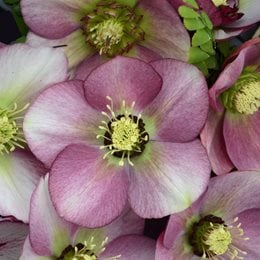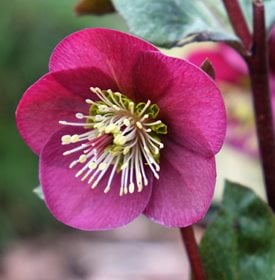Hellebore Flowers Offer Beautiful Late-Winter Blooms
A winter champion, luscious hellebores are some of the first to bloom and are easy to growHellebores provide elegant, long-lasting blooms in late winter and early spring, offering early-season color when little else is in flower. These resilient plants are cherished for their nodding, rose-like blooms and evergreen, dark green foliage, making them a staple in shade gardens. Whether grown in woodland gardens, borders, or containers, hellebores are a reliable choice for adding beauty and structure to the landscape.
On this page: Basics | Types | Planting | Care and Maintenance | Pictures | Design Ideas
On this page:
- BASICS
- TYPES OF HELLEBORES
- PLANTING HELLEBORES
- HELLEBORE CARE AND MAINTENANCE
- HELLEBORE PICTURES
- DESIGN IDEAS
BASICS
Botanical name:
Helleborus spp.
Common names:
Lenten rose, Christmas rose. Hellebores get their common name, Lenten rose, from the rose-like flowers that appear in early spring around the Christian observance of Lent.
Zones:
4 to 9; evergreen in warmer regions (6 to 9)
Exposure:
Partial to full shade
Habit:
Clumping, with upright flower stems and dense basal foliage
Height/Spread:
12 to 24 inches tall and wide
Bloom time:
Late winter to early spring
Flowers:
Nodding or outward-facing cup-shaped blooms in a wide range of colors, including white, pink, purple, yellow, and green, often speckled or veined. Some varieties are double-flowered for an extra showy display.
Foliage:
Evergreen, deeply lobed, leathery dark green leaves, sometimes tinged with burgundy.
Are hellebores poisonous?
All parts of the plant contain toxins that can be harmful to humans and pets if ingested.
Are hellebores rabbit and deer resistant?
Yes, hellebores are resistant to deer and rabbits due to their toxic foliage.
"Hellebores are among the earliest and certainly the most exquisite flowers in the spring garden. The fact that Lenten roses can be successfully grown in most zones, are low-maintenance, and deer-resistant only enhances their already sky-high appeal.”
— Garden designer Jerry Fritz, speaker, author, and nursery owner.
TYPES OF HELLEBORES
- Lenten rose (Helleborus orientalis): Classic species with outward-facing blooms in a variety of colors.
- Christmas rose (Helleborus niger): Early-blooming white flowers that turn pink with age.
- Stinking hellebore (Helleborus foetidus): Unique greenish flowers and deeply cut foliage.
- Hybrids (Helleborus x hybridus): A wide range of hybrid colors and patterns, including double-flowered varieties.
HOW TO PLANT HELLEBORES
When to plant:
Plant hellebores in early spring or fall when the weather is cool, allowing time for root establishment.
Where to plant:
Select a site with dappled or partial shade and well-draining soil. Hellebores thrive under deciduous trees, where they receive winter sun and summer shade.
How to plant:
- Loosen the soil and amend with compost for improved drainage and fertility.
- Dig a hole twice as wide and the same depth as the root ball.
- Remove the plant from its container and gently loosen any bound roots.
- Place the plant so that the crown sits just below the soil surface. Planting too deeply can hinder flower production.
- Backfill, gently firm the soil, and water well.
- Space plants 18 to 24 inches apart.
HELLEBORE CARE
Soil:
Rich, moist, well-draining soil with a neutral to slightly alkaline pH (6.5-7.5) is ideal.
Amendments and fertilizer:
An annual application of compost or well-rotted manure in fall will help to boost the growth of your hellebores. A balanced slow-release fertilizer can be used in early spring.
Watering:
Water regularly during the first year to establish roots. Once established, hellebores are drought tolerant but appreciate occasional deep watering in dry spells.
Pruning and deadheading:
In late winter or early spring, just as new growth stalks are emerging, any old or damaged foliage can be sheared back to the base. Remove spent flowers to prevent excessive self-seeding.
Pests and diseases:
Hellebores are generally pest-resistant but may be bothered by aphids, slugs, or black spot in humid conditions. Provide good air circulation and avoid overhead watering.
Seasonal care:
- Spring: Remove any damaged foliage, apply compost, and fertilize as new growth emerges.
- Summer: Provide occasional deep watering if conditions are dry, but hellebores can tolerate some drought.
- Fall: Apply mulch around plants to insulate roots, particularly in colder regions.
- Winter: In harsh climates, protect young or container-grown plants with burlap or frost cloth during extreme cold snaps.
"Hellebores thrive in well-draining soil, so make sure to amend your soil if it’s heavy or clay-like. Water them regularly, especially during spring and fall when they are actively growing. Summer heat can cause hellebores to go dormant, so they won’t need as much water then."
— Author, speaker, and home gardener Stacy Ling, Bricks & Blooms
OUR FAVORITE HELLEBORES
LANDSCAPING IDEAS FOR HELLEBORES
There are many ways to use hellebores in your landscape, here are a few ideas:
- Under trees and shrubs: Plant hellebores beneath deciduous trees or shrubs for seasonal interest.
- Woodland gardens: Combine with ferns, hostas, and other shade-loving perennials.
- Mass planting: Use hellebores in drifts to create a lush groundcover effect.
- Container planting: Grow hellebores in shaded containers for winter and early spring color.
- On a hillside: Plant hellebore flowers on a hillside or in raised flower beds to better enjoy their downward-facing blooms. See an excellent example of this planting strategy: A Winter Jewel Box.
Companion Plants: Pair with snowdrops, crocuses, bleeding heart, daffodils, and heuchera for layered interest.
"Hellebores are the ultimate shade plant. They are long lived and are susceptible to few diseases and pests, such as deer. The fact that they are basically evergreen only adds to their allure."
— Author, speaker, and designer David L. Culp, Brandywine Cottage
FREQUENTLY ASKED QUESTIONS
Do hellebores spread?
Yes, hellebores will self-sow. However, allowing them to do so may result in unexpected hybrids if you grow multiple types in close proximity. Thin out any new seedlings that are too close to mature plants. Expect self-sown plants to flower after three years.
Do hellebores need to be divided?
It's not usually necessary for the health of the plant; but if you wish to divide them, this is best done in fall. Hellebores can be fussy about being dug up and moved, so it's generally just best to leave them be.
Are hellebores evergreen?
In milder climates (zones 6-9), hellebore foliage remains evergreen. In colder zones, foliage may die back in winter but will regrow in spring.
Are hellebores good for pollinators?
Yes! Hellebore flowers provide an important early nectar source for bees and other pollinators.
How cold can hellebores tolerate?
Hellebores are remarkably cold-hardy, tolerating temperatures as low as -10°F (-23°C) when properly established. Mulching around the base in colder climates can help protect roots during extreme winter conditions.
How do I overwinter container-grown hellebores?
Hellebores grown in containers should be moved to a sheltered location, such as an unheated garage or against a house wall, to protect roots from freezing. Mulch around the base of the pot and avoid excessive watering to prevent root rot.
Find more early bloomers: 16 Winter Flowers for Your Garden
Get more spring gardening ideas








